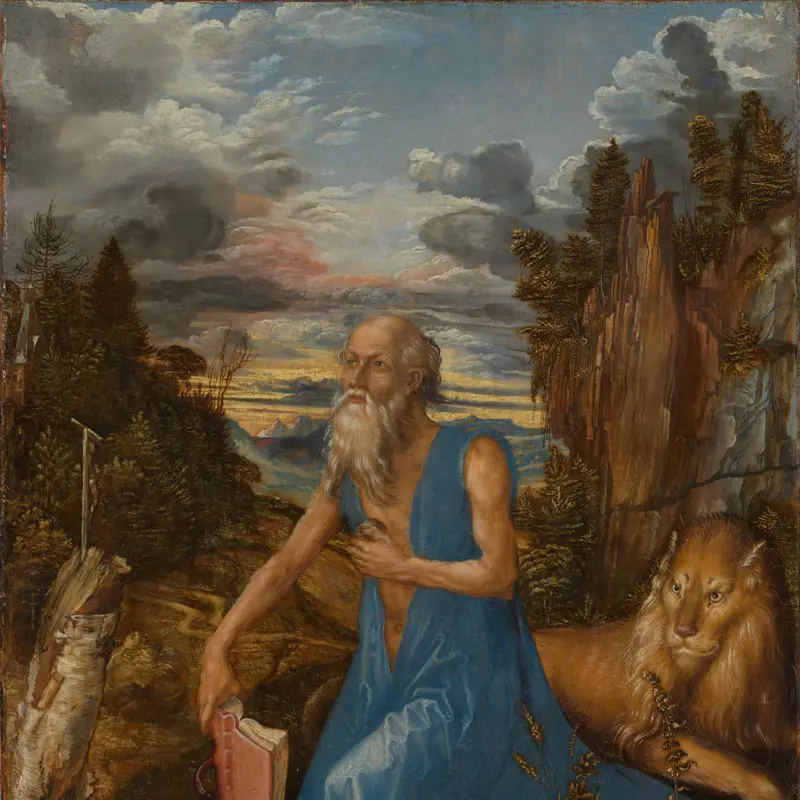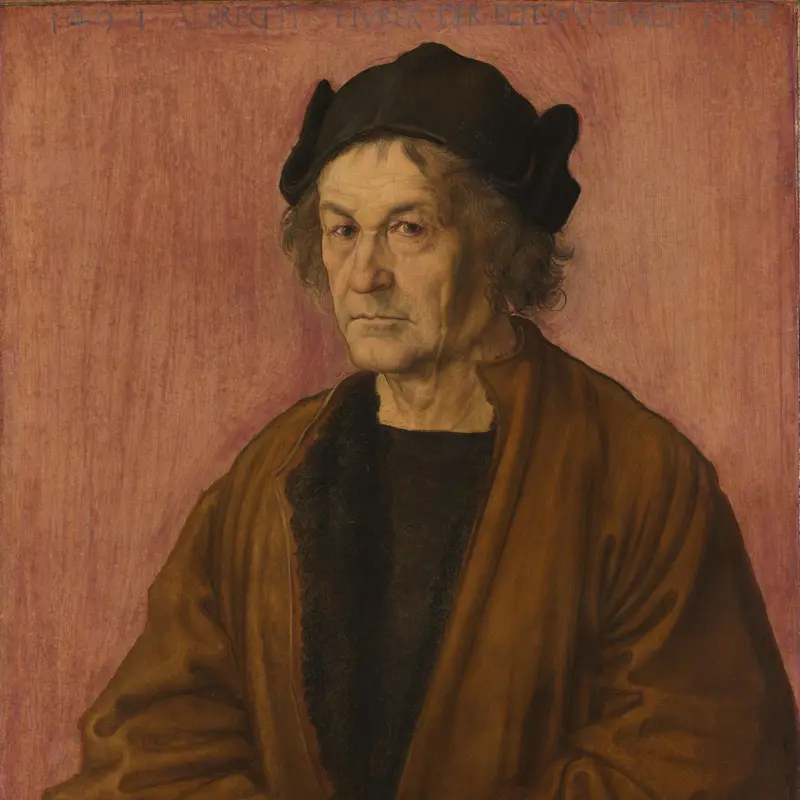Workshop of Albrecht Dürer with Hans Baldung Grien, 'The Virgin and Child ('The Madonna with the Iris')', possibly 1503-8
About the work
Overview
The Virgin Mary breastfeeds the infant Christ in a walled garden surrounded by flowers. God the Father, a small figure radiating light, appears in the sky above. The image of the Virgin and Christ Child in a garden was derived from the poetic imagery of the Song of Solomon, a book of the Old Testament. In it, a woman is described as a lily and a rose as well as an enclosed garden (which, when associated with Mary, came to symbolise her virginity).
This painting was probably made by members of Dürer’s workshop. It includes flowers that are derived from his detailed watercolour studies of the natural world – one of his particular artistic preoccupations – many of which would have been available in the workshop. Each floral element had theological significance: the iris and the rose were associated with the Virgin’s ‘Seven Sorrows’, while the grapevine with large leaves and delicate tendrils was a symbol of the Eucharist (when Christians drink wine at Mass in remembrance of Christ).
Key facts
Details
- Full title
- The Virgin and Child ('The Madonna with the Iris')
- Artist
- Workshop of Albrecht Dürer with Hans Baldung Grien
- Artist dates
- 1471 - 1528; 1484/5 - 1545
- Date made
- Possibly 1503-8
- Medium and support
- Oil on wood (lime, identified)
- Dimensions
- 149.2 × 117.2 cm
- Acquisition credit
- Bought through the Art Fund, 1945
- Inventory number
- NG5592
- Location
- Room 55
- Collection
- Main Collection
- Frame
- 20th-century Replica Frame
Provenance
Additional information
Text extracted from the ‘Provenance’ section of the catalogue entry in Susan Foister, ‘National Gallery Catalogues: The German Paintings before 1800’, London 2024; for further information, see the full catalogue entry.
Exhibition history
-
2010Close Examination: Fakes, Mistakes and DiscoveriesThe National Gallery (London)30 June 2010 - 12 September 2010
-
2014Strange Beauty: Masters of the German RenaissanceThe National Gallery (London)19 February 2014 - 11 May 2014
-
2019Albrecht Dürer (2020)Albertina20 September 2019 - 6 January 2020
-
2021The Credit Suisse Exhibition: Dürer's Journeys: Travels of a Renaissance ArtistThe National Gallery (London)20 November 2021 - 27 February 2022
Bibliography
-
1882M. Thausing, Albert Dürer, His Life and Works, London 1882
-
1902C. Dodgson, The Dürer Society, London 1902
-
1906E. Heidrich, Geschichte des Dürerschen Marienbildes, Leipzig 1906
-
1906M.J. Friedländer, 'Die Ausstellung Altdeutscher Kunst im Burlington Fine Arts Club zu London, Sommer 1906', Repertorium für Kunstwissenschaft, XXIX, 1906
-
1906C. Ricketts, 'Early German Art at the Burlington Fine Arts Club, III: Dürer and His Successors', The Burlington Magazine, IX/40, 1906, pp. 264-8
-
1909G. Glück, 'Fälschungen auf Dürers Namen aus der Sammlung Erherzog Leopold Wilhelms', Jahrbuch der Kunsthistorischen Sammlungen in Wien, 1909, pp. 1-25
-
1913H.F. Cook (ed.), A Catalogue of the Paintings at Doughty House, Richmond and Elsewhere in the Collection of Sir Frederick Cook, Bt, 3 vols, London 1913
-
1928E. Flechsig, Albrecht Dürer - sein Leben und seine künstlerische Entwicklung, Berlin 1928
-
1928H. Tietze and E. Tietze-Conrat, Kritisches verzeichnis der werke Albrecht Dürers, 2 vols, Augsburg 1928
-
1937H. Tietze and E. Tietze-Conrat, Kritisches Verzeichnis der Werke Albrecht Dürers: Band II, der reife Dürer, Basel 1937
-
1945E. Panofsky, Albrecht Dürer, London 1945
-
1945C. Dodgson, 'Dürer's Virgin with the Iris', The Burlington Magazine, LXXXVII/512, 1945, pp. 273-6
-
1947K.R. Towndrow, 'A Note upon Dürer's "Virgin with the Iris" Lately Acquired by the National Gallery', The Burlington Magazine, LXXXIX/529, pp. 100-2
-
1955The National Gallery, The National Gallery: 1938-1954, London 1955
-
1959Levey, Michael, National Gallery Catalogues: The German Schools, London 1959
-
1961L.D. Ettlinger, 'Reflections on German Paintings: Review of Michael Levey, the German School, 1959', The Burlington Magazine, CIII/697, 1961, pp. 132-8
-
1962O. Beyer, 'Dürers herrlichstes Madonnenbild - Begegnung mit dem Londoner Original', Neue Schau, 1962, pp. 434-9
-
1978H. Baldung Grien, Das graphische Werk: Vollständiger Bildkatalog der Einzelholzschnitte, Buchillustrationen und Kupferstiche, ed. M. Mende, Nuremberg 1978
-
1983G. von der Osten, Hans Baldung Grien: Gemälde und Dokumente, Berlin 1983
-
1985F. Koreny, Albrecht Dürer und die Tier- und Pflanzenstudien der Renaissance (exh. cat. Albertina, 18 April - 10 June 1985), Munich 1985
-
1986K. Mittelstädt, Albrecht Dürer, Berlin 1986
-
1991F. Anzelewsky, Albrecht Dürer: Das malerische Werk, revised edn, Berlin 1991
-
1993P. Strieder, Tafelmalerei in Nürnberg, 1350-1550, Königstein im Taunus 1993
-
2000P. Ackroyd et al., 'A Virgin and Child from the Workshop of Albrecht Dürer?', National Gallery Technical Bulletin, XXI, 2000, pp. 28-42
-
2001
C. Baker and T. Henry, The National Gallery: Complete Illustrated Catalogue, London 2001
-
2005E. Danziger, 'The Cook Collection: Its Founder and Its Inheritors', in Christie's, Old Master Pictures, London 2005, pp. 44-54
-
2024S. Foister, National Gallery Catalogues: The German Paintings before 1800, 2 vols, London 2024
About this record
If you know more about this work or have spotted an error, please contact us. Please note that exhibition histories are listed from 2009 onwards. Bibliographies may not be complete; more comprehensive information is available in the National Gallery Library.





